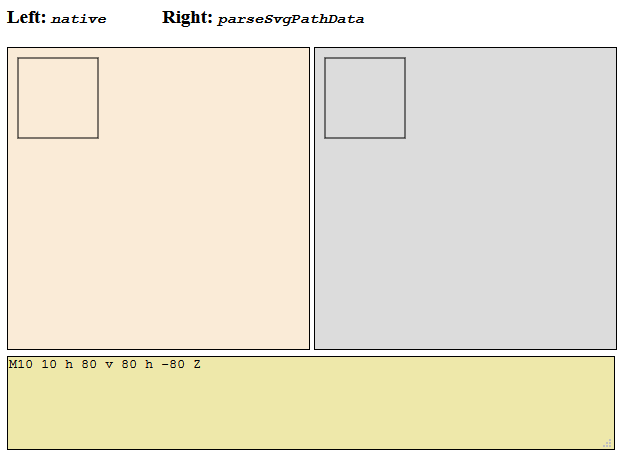parse-svg-path-data v0.2.1
parseSvgPathData
parseSvgPathData is a SVG path data micro-parser for parsing the path data attribute of the SVG <path> element as a single JavaScript function.
function parseSvgPathData(data,[ifc],[ctx])datais the SVG path data string (e.g."M 100 100 L 300 100 L 200 300 z").ifcis an interface object optional (see below)ctxis a context object the interface methods will operate on optional.return's the context object.

The fact that a user defined interface object should be supported, was considered a critical feature here. Similar libraries, which do not support this, are:
- parse-svg-path A minimal svg path parser
- svg-path-parser A parser for SVG's path syntax
- svg-pathdata Parse SVG PathDatas
Interface Object
Interface objects need to have the following interface structure:
{
init(ctx),
A(rx,ry,rot,fA,fS,x,y),
C(x1,y1,x2,y2,x,y),
H(x),
L(x,y),
M(x,y),
Q(x1,y1,x,y),
S(x2,y2,x,y),
T(x,y),
V(y),
Z(),
a(rx,ry,rot,fA,fS,x,y),
c(x1,y1,x2,y2,x,y),
h(x),
l(x,y),
m(x,y),
q(x1,y1,x,y),
s(x2,y2,x,y),
t(x,y),
v(y),
z()
}parseSvgPathData comes with two implemented Interfaces as members of the
parseSvgPathData function object itself.
parseSvgPathData.defaultIfcparseSvgPathData.canvasIfc
Have a look into the source how these interface objects are implemented and start to implement your own custom interface object.
defaultIfc
When calling the parseSvgPathData function without interface object ifc and context ctx parameters (e.g. parseSvgPathData('M0,0 L100,0')), the default interface object parseSvgPathData.defaultIfc will be taken.
By using this interface object the command segments are simplified and mapped to a minimal set of absolute path commands [A,L,M,C] in object notation.
So parsing the path data M37,17v15H14V17z M50,0H0v50h50z using this interface object will result in the object structure:
[ {"type":"M","x":37,"y":17},
{"type":"L","x":37,"y":32},
{"type":"L","x":14,"y":32},
{"type":"L","x":14,"y":17},
{"type":"L","x":37,"y":17},
{"type":"M","x":50,"y":0},
{"type":"L","x":0,"y":0},
{"type":"L","x":0,"y":50},
{"type":"L","x":50,"y":50},
{"type":"L","x":50,"y":0}
]canvasIfc
canvasIfc is another interface object, which is supplied with parseSvgPathData. Here every path command will invoke corresponding HTML canvas 2D methods.
Please notice my paper A Generalized Approach to Parameterizing Planar Elliptical Arcs in this context.
The following will render the path data in a given canvas element:
const ctx = document.getElementById('canvas').getContext('2d')
// ...
parseSvgPathData('M10,10 L100,10',parseSvgPathData.canvasIfc,ctx);
ctx.stroke()
ctx.fill()You might know, that CanvasRenderingContext2D supports the Path2D interface. So we can also use it with parseSvgPathData
const path = new Path2D();
// ...
parseSvgPathData('M10,10 L100,10',parseSvgPathData.canvasIfc,path);or even simpler
const path = parseSvgPathData('M10,10 L100,10',
parseSvgPathData.canvasIfc,
new Path2D());Please note, that parseSvgPathData might be useful despite the fact, that Path2D natively understands and supports SVG path data.
const path = new Path2D('M10,10 L100,10');You can see the results of both the native and parseSvgPathData output side by side here.
License
parseSvgPathData.js is licensed under the terms of the MIT License. See License for details.
FAQ
--
Change Log
All notable changes to this project will be documented here. This project adheres to Semantic Versioning.



